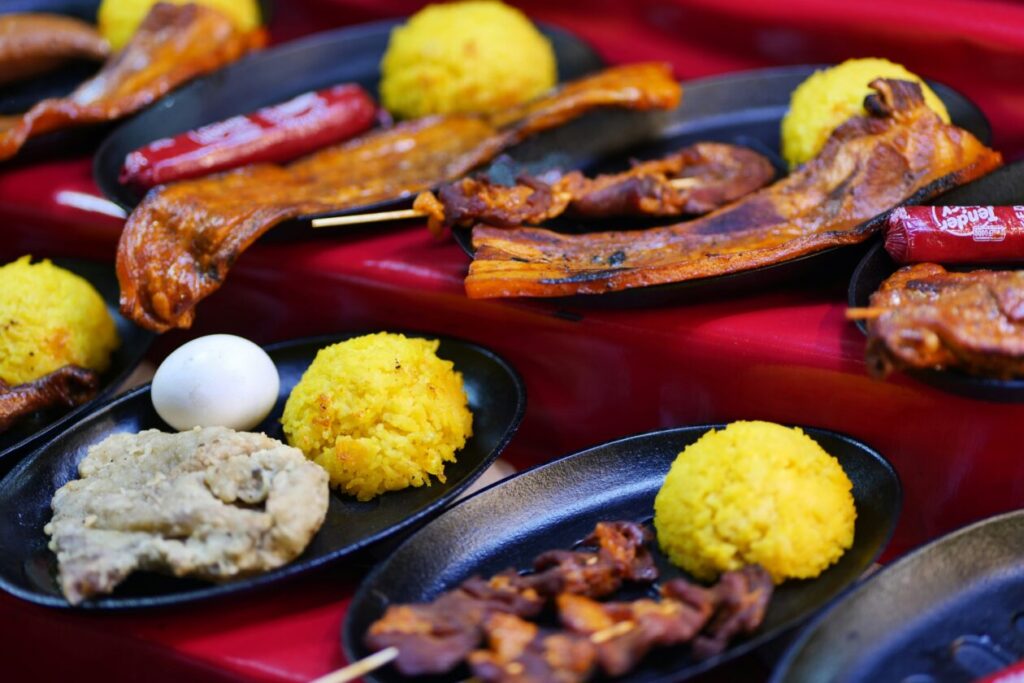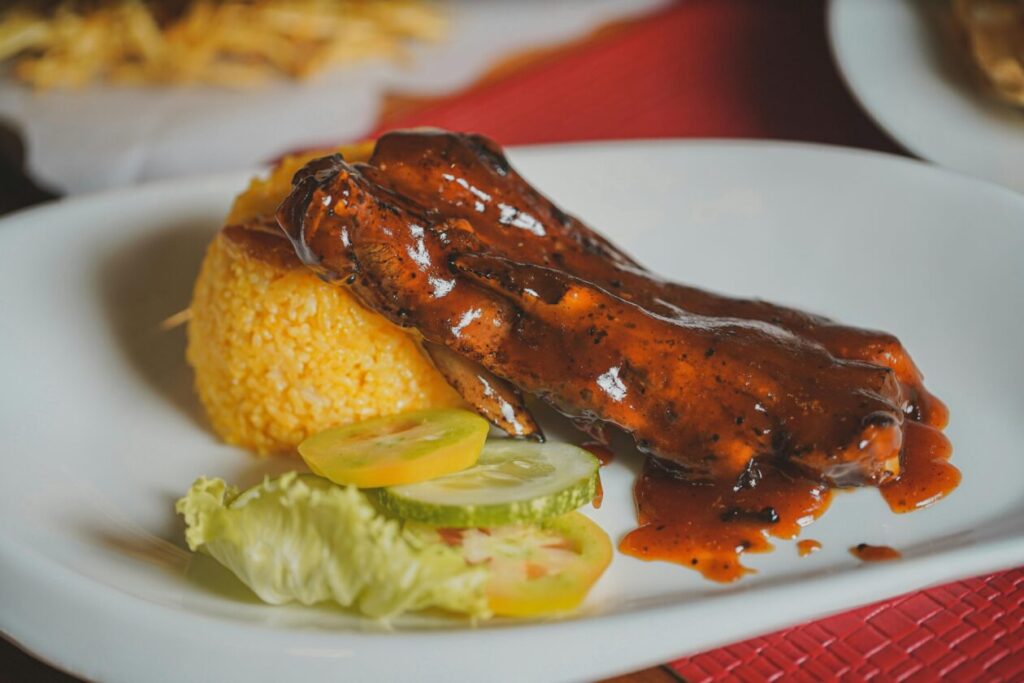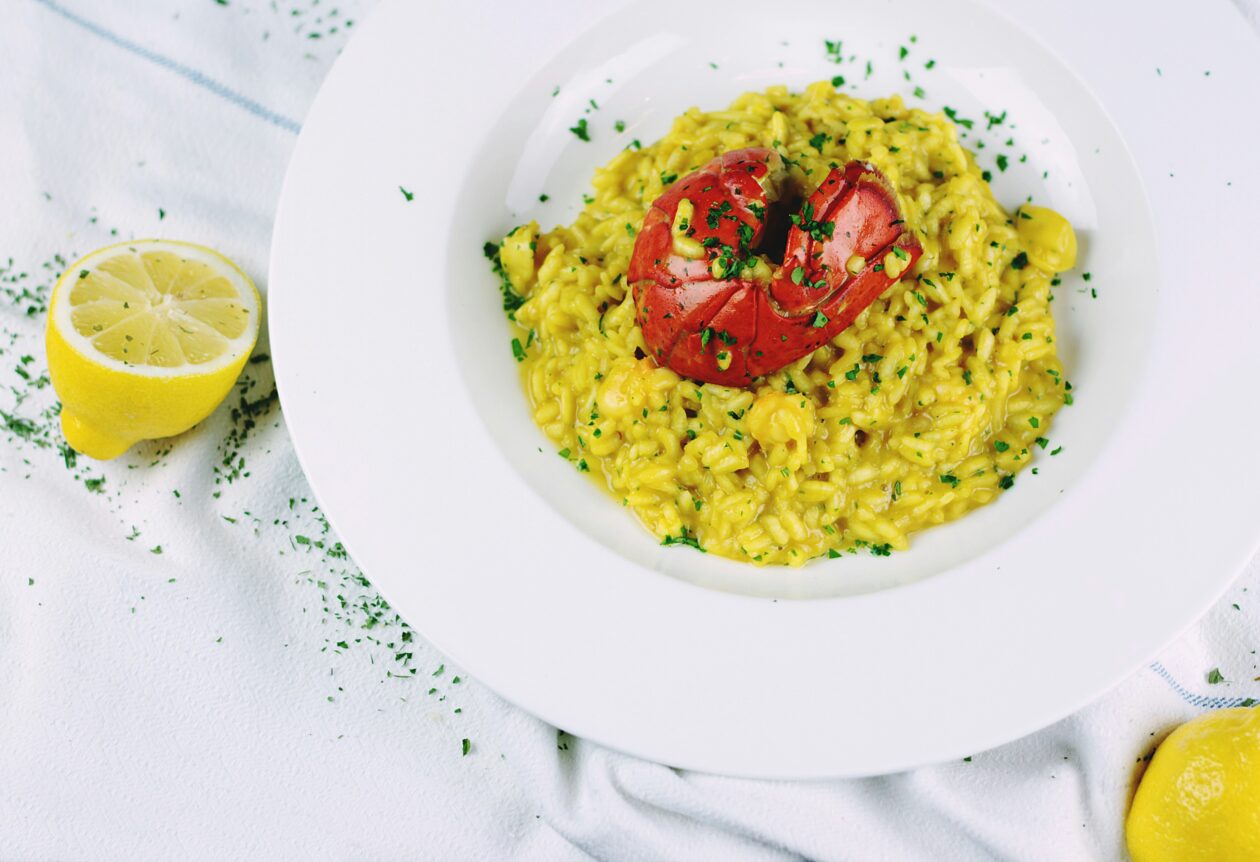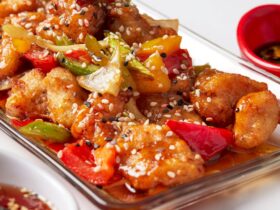Introduction
Renowned for its vibrant hue and enticing aroma, yellow rice has become a culinary staple in various cuisines worldwide. Frequently savored as a delectable side dish, its allure lies in the infusion of spices such as annatto, saffron, or turmeric, imparting a multifaceted flavor profile and striking color. With strong associations with Asian, Middle Eastern, and Latin American gastronomy, yellow rice is cherished on dining tables across the globe. However, amidst its widespread popularity, many ponder: Is yellow rice good for weight loss?
When people try to eat healthier, the question of whether yellow rice may be included in a weight loss plan comes up. This investigation looks into the nutritional value of yellow rice and whether eating it helps people lose weight. Although it is commonly considered a mealtime food high in carbohydrates, there is much to consider regarding its possible effects on weight loss. Let’s closely examine the subject to determine whether yellow rice belongs to a calorie-conscious diet.
Understanding Yellow Rice
Distinguished by its vivid hue and fragrant taste, yellow rice is essential to many international culinary customs. This food, which comes from parts of Latin America, Asia, and the Middle East, is distinguished by the bright yellow color it gets with the addition of different spices and condiments. The specific ingredients may differ based on recipes and cultural preferences. Still, popular additions to the rice are annatto, saffron, or turmeric, each of which gives it a unique flavor and color.
Yellow rice, or “arroz amarillo,” is frequently served with meals like arroz con pollo in Latin American cooking, providing a tasty foundation for chicken and vegetables. Similar to this, yellow rice is commonly used in Asian cuisine, particularly in dishes like biryani, where it creates layers of aromatic rice that are infused with spices, meat, or vegetables. Yellow rice is a tasty side dish representing many countries’ culinary traditions and legacy.
Although white rice is often the foundation of yellow rice recipes, those concerned about their health and want to use this dish to reduce weight can choose healthier substitutes. White rice can be replaced with brown or cauliflower rice, which has fewer carbs and more fiber. People can enjoy yellow rice’s rich flavors and still follow their weight loss objectives by substituting these foods and including them in a balanced diet.
Nutritional Profile of Yellow Rice

For those thinking about using yellow rice in their weight loss quest, it is vital to comprehend its nutritional makeup. An in-depth analysis of the calories, carbohydrates, fiber, and fat content per serving provides important information.
One cup of cooked yellow rice has about 216 calories in a usual serving. With roughly 44.4 grams per serving, carbohydrates comprise most of its macronutrient profile. Even while carbohydrates provide energy, you should watch how much you eat, especially if trying to lose weight.
A serving of yellow rice provides about 2.6 grams of fiber in addition to carbohydrates. In addition to helping with digestion and inducing satiety, fiber has been shown to positively affect appetite control and weight management. Additionally, using foods high in fiber, such as yellow rice, in meals can support general health and a balanced diet.
Yellow rice has several nutritional advantages, but you should know its fat content. Despite being relatively low—about 1.8 grams per serving—people should consider their total fat consumption when developing a weight loss plan. Choosing cooking techniques that reduce the amount of extra fat and oil added will help control the fat content while preserving the flavor of yellow rice.
Nutrition Facts for Weight Loss (per 100g)(source: USDA)
- Energy: 88 kcal
- Protein: 1.8g
- Total Lipid (Fat): 0.45g
- Carbohydrate, by difference: 19.1g
- Fiber, Total Dietary: 0.5g
Minerals:
- Calcium (Ca): 12mg
- Magnesium (Mg): 30mg
- Potassium (K): 195mg
- Sodium (Na): 340mg
Vitamins:
- Thiamin: 0.081mg
- Riboflavin: 0.029mg
- Niacin: 0.898mg
- Vitamin B-6: 0.141mg
- Folate (Total): 25µg
- Vitamin E (Alpha-Tocopherol): 0.06mg
This simplified nutrition profile focuses on key nutrients relevant to weight loss efforts. It provides information on energy content, macronutrients like protein and fat, and important micronutrients such as fiber and vitamins. Including foods with such a nutrient profile in a balanced diet can support weight management goals effectively.
In conclusion, anyone looking to include yellow rice in their weight loss regimen must know its nutritional makeup. Knowing how many calories, carbohydrates, fiber, and fats are in each serving allows people to make decisions that fit their preferences and dietary objectives. A balanced diet that includes yellow rice in moderation can improve weight management goals by providing a tasty and fulfilling meal supplement.
Role of Carbohydrates in Weight Loss
Our diets are largely composed of carbohydrates, affecting our attempts to lose weight in several ways. Our body uses these macronutrients as its main energy source to power physical activities and necessary internal processes. However, not all carbohydrates are made equal, and it’s important to know how they affect controlling weight.
The glycemic index (GI) is crucial to understanding carbs and weight loss. Carbs are ranked on the Glycemic Index (GI) according to how quickly they boost blood sugar levels after eating. High GI foods are quickly absorbed and digested, causing a blood sugar rise and subsequent drop that can make you feel peckish and want more food. Low-GI foods, on the other hand, digest more slowly, raising blood sugar levels gradually and releasing energy more gradually.
Low to intermediate GI carbs are normally advised when selecting them for weight management. These consist of fruits, vegetables, legumes, and whole grains, including barley, quinoa, and brown rice. Essential nutrients, fiber, and antioxidants in these foods help promote general health and sensations of fullness and satiety.
Meals containing low-to-moderate GI carbs can help control blood sugar, lessen cravings, and increase the likelihood of successful long-term weight loss. Furthermore, combining carbs with foods high in protein, fiber, and healthy fats will help maintain regulated blood sugar levels throughout the day and improve satiety. People can still have delicious and fulfilling meals and improve their diet for weight management by prioritizing nutrient-dense carbs and making thoughtful food choices.
Fiber Content in Yellow Rice

Despite not being commonly linked to weight loss, yellow rice has some surprisingly beneficial properties, especially because of its high fiber content. Because it has so many bodily functions, including assisting with digestion, encouraging fullness, and controlling blood sugar levels, fiber is an essential vitamin for managing weight.
The function of fiber in yellow rice in digesting is one of its main advantages. Fiber gives feces more volume, which facilitates and encourages regular bowel movements. Fiber keeps the digestive system running smoothly, which helps avoid bloating and constipation—two typical problems for people attempting to lose weight.
Additionally, fiber helps with post-meal sensations of fullness and satisfaction. Fiber-rich foods take longer to digest, which prolongs feelings of fullness and decreases the chance of overindulging or between-meal snacking. Yellow rice can help you feel filled for longer, making it easier to follow a diet that limits calories and portions.
Furthermore, yellow rice’s fiber can support blood sugar regulation. Fiber prevents blood sugar spikes and falls by slowing down the absorption of sugar into the bloodstream. This consistent energy delivery can help weight loss by reducing cravings for high-calorie or sugary foods.
Including fiber-rich foods like yellow rice will help you control your weight. Yellow rice may be a useful addition to a balanced diet since fiber is critical in maintaining general health and well-being by encouraging good digestion, improving satiety, and controlling blood sugar levels.
Turmeric and Weight Loss
The spice that gives yellow rice its vivid yellow hue, turmeric, has drawn interest for its culinary use and health advantages, including weight loss. The active ingredient in turmeric, curcumin, is well-known for its anti-inflammatory and metabolism-enhancing qualities.
Curcumin, the main bioactive ingredient in turmeric, has been linked to weight loss through its ability to reduce inflammation in the body, according to studies. Curcumin’s anti-inflammatory qualities may help counteract the consequences of chronic inflammation, which are connected to obesity and metabolic problems, encouraging weight loss and general wellness.
Moreover, studies indicate that curcumin can contribute to increased fat-burning and metabolism. Curcumin may improve the body’s nutrient utilization and aid in weight loss by boosting the synthesis of enzymes that aid in the metabolism of fats and carbs.
Including turmeric in your diet—whether in yellow rice or other recipes—may provide advantages beyond its eye-catching hue and unique taste. Turmeric can be a useful ally in your weight reduction quest by utilizing the potential of curcumin, improving general health and well-being in the process.
Incorporating Yellow Rice into a Weight Loss Plan
Including yellow rice in your diet can be a tasty and fulfilling approach to maintaining a balanced diet while achieving your fitness objectives. It’s crucial to mindfully approach this vibrant staple’s consumption, controlling portion sizes and using healthy cooking methods to get the most out of it.
One useful tactic is treating yellow rice as an accent rather than the centerpiece of a well-balanced meal. You may make a well-balanced plate that delivers necessary nutrients and controls calorie consumption by serving it with lean proteins like grilled chicken or fish and lots of veggies.
Portion control is another essential component of a yellow rice diet for weight loss. Although adding yellow rice to meals might be a healthy option, limiting consumption is crucial. You can still enjoy the colorful tastes of this dish and keep within your calorie goals by choosing smaller serving sizes and packing the rest of your plate with nutrient-dense foods like leafy greens and lean proteins.
Instead of frying or sautéing yellow rice, choose healthier cooking techniques like steaming or boiling. This keeps the rice’s natural flavors and nutritional qualities intact while reducing the amount of additional fats and calories. Add more veggies or herbs to increase fiber and vitamin content to improve the dish’s weight reduction profile.
You may appreciate yellow rice’s mouthwatering flavor and vivid color while assisting in your weight loss efforts by consuming it mindfully and in moderation. A nutritious diet that supports general health and well-being can be achieved by thoughtfully and equitably including this adaptable component into your meals.
Alternatives to Yellow Rice for Weight Loss
When thinking about low-calorie alternatives to yellow rice, things like quinoa or cauliflower rice stand out as great choices because they’re high in nutrients and have a lot of culinary applications. Compared to traditional yellow rice, these substitutes have fewer calories and carbs, which makes them the perfect option for anyone trying to control their weight.
For example, cauliflower rice is a well-liked low-carb substitute that greatly lowers calorie and carbohydrate intake while closely resembling the texture and appearance of regular rice. Cauliflower rice, produced by shredding or processing cauliflower into tiny grains resembling rice, is a wholesome addition to any diet plan for weight loss because it is high in fiber, vitamins, and minerals. Because of its bland flavor, it also readily absorbs the flavors of other ingredients, creating many imaginative and delicious recipe combinations.
In contrast, quinoa is a high-nutrient whole grain that contains antioxidants, fiber, and all the essential amino acids. It also has a complete protein profile. Although quinoa has more calories and carbs than cauliflower rice, it offers a wider variety of nutrients and, when eaten in moderation, can be a useful part of a balanced diet for weight management. Its robust texture and nutty flavor make it a pleasant substitute for yellow rice, ideal for boosting weight management objectives by adding diversity to meals.
To improve flavor without sacrificing nutritional content, try experimenting with different herb and spice combinations when adding these substitutes to your meal plans for weight loss. Whether you choose quinoa or cauliflower rice, controlling portions and practicing mindful eating is still crucial for successfully reducing weight and keeping it off. If you choose these healthy substitutes, you may achieve your fitness and health objectives while enjoying tasty and fulfilling meals.
Additional Considerations
While there are many advantages to including yellow rice in a weight reduction strategy, it’s important to consider certain possible drawbacks and concerns to make well-rounded dietary decisions. You should know yellow rice’s sodium content, especially if you’re on a low-sodium diet or managing health issues like hypertension. Many commercially available yellow rice mixtures could have extra salt added for flavor, so read the nutrition label and choose low- or no-sodium versions whenever you can. Alternatively, make your yellow rice from scratch with whole ingredients and seasonings to better manage sodium.
Furthermore, yellow rice should be consumed cautiously by those with specific food allergies or sensitivities, particularly if it contains substances like wheat or gluten, which can cause negative reactions in vulnerable people. Review the ingredient list and select items that fit your dietary requirements and limits. A registered dietitian or other healthcare professional can offer individualized advice and recommendations based on your unique health profile if you need to know if yellow rice is appropriate for your dietary needs.
Those looking for more details and direction regarding including yellow rice in a diet should speak with a nutritionist or dietitian, who can provide insightful analysis and individualized recommendations. These experts can evaluate your dietary choices, nutritional requirements, and weight reduction objectives to create a customized meal plan that incorporates yellow rice in a balanced and beneficial manner. Furthermore, they can offer tools for portion management plans, cooking methods, and dish ideas to maximize yellow rice’s nutritional value and help you lose weight.
In summary, yellow rice can be a tasty and nourishing complement to a diet for weight loss. Still, knowing about potential issues like food allergies and sodium levels is important. You may benefit from yellow rice while advancing your general health and wellness objectives by making well-informed decisions, getting expert advice when necessary, and maintaining a balanced eating habit. Consider variety, moderation, and portion control essential to a long-term, effective weight-loss strategy.
Is Yellow Rice Good for Weight Loss?

A. Short Answer:
Yes, yellow rice can be a part of a weight loss diet when consumed in moderation and as part of a balanced meal plan.
B. In-Depth Analysis:
Yellow rice, a staple in many cuisines, can be included in a weight loss plan due to its nutritional profile and versatility. While it’s higher in carbohydrates than other grains, it also offers essential nutrients and can contribute to satiety when paired with lean proteins and vegetables. Yellow rice is typically made by infusing white rice with turmeric or saffron, giving it a vibrant color and a mild, earthy flavor.
Focusing on portion control and pairing yellow rice with nutrient-dense foods is important when considering weight loss. For example, you can combine it with grilled chicken breast and steamed vegetables for a balanced meal with protein, fiber, and essential vitamins and minerals. Additionally, choosing whole grain varieties of yellow rice can increase its fiber content, which aids in digestion and helps to keep you feeling full for longer periods, supporting weight management efforts.
It’s worth noting that while yellow rice can be part of a weight loss diet, it’s essential to consider overall calorie intake and balance it with physical activity. Incorporating yellow rice into meals in moderation and other whole foods can contribute to a sustainable approach to weight loss and overall health.
In summary, yellow rice can be included in a weight-loss diet in moderation and as part of a balanced meal plan. You can create satisfying and nutritious meals that support your weight management goals by pairing them with lean proteins, vegetables, and whole grains. Remember to focus on portion control, choose exclusive grain varieties when possible, and maintain a balanced diet for long-term success.
FAQs About Yellow Rice and Weight Loss
1. Is yellow rice good for people with diabetes?
Yellow rice, like other types of rice, contains carbohydrates that can impact blood sugar levels. While it can be included in moderation as part of a balanced diabetic diet, individuals with diabetes need to monitor portion sizes and consider the overall carbohydrate content of their meals.
2. Is yellow rice high in carbs?
Yes, yellow rice is relatively high in carbohydrates, the primary macronutrient found in rice. It’s important to be mindful of portion sizes, especially for those following low-carb diets or managing conditions like diabetes.
4. Is yellow rice or white rice healthier?
Both yellow rice and white rice have similar nutritional profiles, but yellow rice is often infused with turmeric or saffron, adding flavor and potential health benefits. However, whole-grain varieties like brown or wild rice are generally healthier due to their higher fiber content and additional nutrients.
5. Yellow rice calories
The calorie content of yellow rice can vary depending on factors such as serving size and preparation method. On average, one cup of cooked yellow rice contains approximately 200-220 calories.
6. Yellow rice calories 100g
The calorie content of 100 grams of cooked yellow rice is approximately 130-140 calories, but this can vary slightly based on specific brands and cooking methods.
7. Is yellow rice unhealthy?
Yellow rice can be part of a healthy diet when consumed in moderation as a balanced meal plan. However, like any food, excessive consumption may contribute to health issues such as weight gain or elevated blood sugar levels.
8. Can I eat yellow rice on a diet?
Yes, yellow rice can be included in a diet focused on weight loss or overall health when consumed in moderation and as part of a balanced diet emphasizing whole foods and portion control.
9. What is the best rice for weight loss?
Whole grain varieties of rice, such as brown rice or wild rice, are generally considered better options for weight loss due to their higher fiber content and slower digestion, which can help keep you full for longer periods.
10. Is yellow rice a bad carb?
Yellow rice, like other types of rice, is primarily composed of carbohydrates. While it’s not necessarily a “bad” carb, monitoring portion sizes and considering overall dietary balance when including it in your meals is important.
11. Does yellow rice break down into sugar?
Yes, like all carbohydrate-containing foods, yellow rice is broken down into sugar (glucose) during digestion, impacting blood sugar levels. Individuals with diabetes or those watching their sugar intake should be mindful of portion sizes and overall carbohydrate consumption.
12. Can I lose weight by eating rice?
Yes, it’s possible to lose weight while including rice in your diet, as long as you manage portions and incorporate them into a balanced diet of various nutrient-dense foods.
13. What color rice is better for weight loss?
Whole grain varieties of rice, such as brown rice, black rice, or red rice, are generally considered better options for weight loss due to their higher fiber content and additional nutrients than white rice.
14. Should rice be avoided for weight loss?
Rice can be part of a healthy weight loss diet when consumed in moderation and as part of a balanced meal plan. However, portion control and choosing whole grain varieties are essential for losing weight.
15. How much rice should I eat daily to lose belly fat?
There is no one-size-fits-all answer to this question, as individual calorie needs and weight loss goals vary. However, portion control and moderation are key to remember when including rice or any other carbohydrate-containing food in a weight-loss diet.
16. How much rice should I eat a day to lose weight?
The amount of rice you should eat daily to lose weight depends on your overall calorie needs, activity level, and individual preferences. It’s best to work with a healthcare professional or registered dietitian to determine personalized dietary recommendations.
17. How do the Chinese eat rice and stay thin?
In Chinese cuisine, rice is often served as part of a balanced meal that includes a variety of vegetables, proteins, and other nutrient-rich foods. Portion control, a focus on whole foods, and mindful eating may contribute to weight management in Chinese dietary traditions.
18. What to eat for weight loss?
A balanced weight loss diet includes a variety of nutrient-dense foods such as fruits, vegetables, lean proteins, whole grains, and healthy fats. Portion control, hydration, and regular physical activity are important factors for weight loss.
19. Can rice reduce belly fat?
While rice alone cannot target belly fat specifically, including whole grain varieties of rice as part of a balanced diet emphasizing overall calorie control and regular physical activity may contribute to weight loss, including reduced belly fat over time.
Conclusion
In summary, yellow rice may add flavor to your diet, but its ability to help you lose weight depends on several conditions. Incorporating yellow rice into a well-balanced diet can help manage weight while providing vital nutrients. Spices like turmeric, which includes curcumin, a substance with possible anti-inflammatory effects, are typically responsible for its brilliant color. Furthermore, yellow rice can help you lose weight by giving you the energy you need for your exercises and other activities.
It’s crucial to consume yellow rice proportionately and with awareness. Rice, especially yellow rice, has a high carbohydrate content that might affect blood sugar levels and total calorie consumption. Therefore, portion control is essential. If you eat a well-balanced diet with lots of fruits, vegetables, lean proteins, healthy fats, and yellow rice, you can be sure you’re getting various nutrients while controlling your weight.
Ultimately, the greatest strategy for losing weight when eating yellow rice—or any other food—is to pay attention to your body and make decisions based on your unique dietary tastes and objectives. Try various recipes and meal combinations to see what suits you the best. When including yellow rice in your diet, remember that maintaining an active lifestyle, portion control, and overall balanced nutrition are the keys to long-term weight management success.
Reference
How to add more fiber to your diet. (2022). Mayo Clinic. https://www.mayoclinic.org/healthy-lifestyle/nutrition-and-healthy-eating/in-depth/fiber/art-20043983
All carbohydrates are not created equal – Mather Hospital. (2019, April 8). Mather Hospital. https://www.matherhospital.org/weight-loss-matters/all-carbohydrates-are-not-created-equal/
Chanita Unhapipatpong, Nint Polruang, Prapimporn Chattranukulchai Shantavasinkul, Narachai Julanon, Pawin Numthavaj, & Ammarin Thakkinstian. (2023). The effect of curcumin supplementation on weight loss and anthropometric indices: an umbrella review and updated meta-analyses of randomized controlled trials. The American Journal of Clinical Nutrition, 117(5), 1005–1016. https://doi.org/10.1016/j.ajcnut.2023.03.006
Thomas, D., Elliott, E. J., & Baur, L. (2007). Low glycaemic index or low glycaemic load diets for overweight and obesity. The Cochrane Database of Systematic Reviews, 2007(3). https://doi.org/10.1002/14651858.CD005105.pub2
Blumberg, P. O. (2022, July 13). Rice Is a Carb You Should Stop Avoiding. Men’s Health; Men’s Health. https://www.menshealth.com/nutrition/a40581922/is-rice-good-for-you/
Was this helpful?

Joseph Emb, RDN
Founder of StyleVitally.com | Registered Dietitian & Wellness Advocate
What I Cover:
I’m passionate about connecting nutrition science and everyday wellness to help people live healthier, more vibrant lives. I write about evidence-based nutrition, mindful eating, sustainable lifestyles, and holistic well-being at StyleVitally.com.
My Background:
The University of Texas in Austin, where I earned my Dietetics diploma, laid the groundwork for my nutrition and health career. My training and hands-on experience taught me the science and art of using nutrition to enhance health and well-being.
Professional Journey:
I’m an RDN with lots of experience. I’ve helped people seeking tailored nutritional recommendations in clinical settings and community outreach programs. My constant learning and professional development ensure that my recommendations are always based on the latest evidence.
Ethical Commitment:
My practice prioritizes integrity. My content is transparent and objective, following the most significant ethical standards. I can give my audience unbiased advice because I’m not affiliated with food businesses or industry associations. I want to help people make informed health decisions that match their values and ambitions.
Join Me on the Wellness Journey:
Join me on the path to vitality and well-being, whether facing nutritional issues, seeking sustainable lifestyle changes, or simply wanting a better, happier you. We’ll discover how diet, mindfulness, and holistic well-being can maximize your potential.










Leave a Reply
View Comments